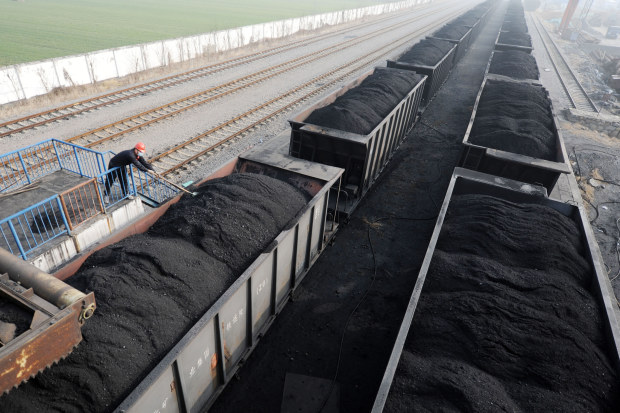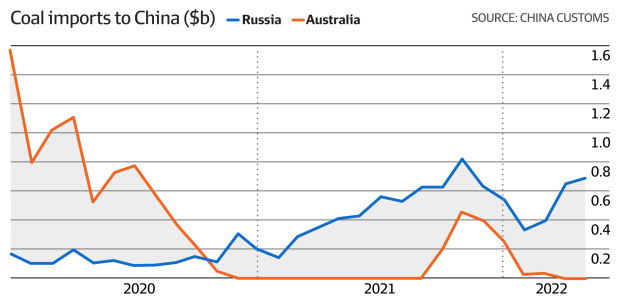Australia punished as Russian coal helps China
Ronald Mizen
Jul 4, 2022
China’s deepening alliance with Russia has led Beijing to boost purchases of Vladimir Putin’s cut-price coal while continuing to punish Australian exporters.
The value of Russian coal imports into China rose sharply following Beijing’s trade sanctions on Australia in late 2020, and more than doubled between February and May this year following the Ukraine conflict.
The value of Russian coal imports into China has more than doubled between February and May. Getty
At the same time, except for a small spike between October and February, the value of Australian coal imports plummeted to nothing, according to analysis of China Customs data.
Trade Minister Don Farrell said as a major player in the international community there was a role for China in relation to Russia’s bloody invasion of Ukraine.
“China has a special responsibility as a global leader and a permanent member of the UN Security Council to take a clear stand in support of Ukraine. But it has not done so,” Mr Farrell said.
The volume of Russian coal shipments to China increased by about 20 per cent in May and was up about 50 per cent in June compared to the year before, according to S&P Global Market Intelligence.
The lift coincided with a ban on all Russian coal imports into the European Union set to come into effect in August, which the EU estimated would deprive Moscow of at least €8 billion ($12 billion) a year. Japan and the United States have also announced import restrictions on Russian coal.
The bans prompted Russia to offer deeply discounted coal which, according to S&P, is being shipped to China, the Mediterranean, India and western European nations looking to stockpile the commodity ahead of the ban. Russia is now one of China’s largest suppliers of metallurgical coal.
Resource Minister Madeleine King said despite China shunning Australia, local miners had pivoted rapidly.
“Exports to Japan, South Korea, Taiwan and India grew rapidly, and replaced Indonesian, South African, Canadian and Russian cargoes that had been heading to those countries but were now going to China,” she said.
“Overall Australian coal export volumes [for metallurgical and thermal coal] edged down by 1.5 per cent in 2021, relative to 2020, but increased by 46 per cent in value terms due to strong growth in global coal prices.”
Travelling from a NATO summit in Madrid, Prime Minister Anthony Albanese visited Ukraine, where he stepped up sanctions on Russia and promised to stand with the war-torn nation “for as long as it takes”.
Mr Albanese announced an import ban on Russian gold and sanctions and travel bans on 16 more Russian ministers and oligarchs, bringing the total number of individuals sanctioned to 843, and 62 entities.
NATO, the military alliance between 32 North Atlantic countries, last week accused Beijing of conspiring with Moscow to subvert the international rules-based order, and identified China for the first time as a global threat.
In 2020, China imposed trade restrictions on Australian lobster, beef, cotton and timber exports, placed tariffs of up to 212 per cent on wine and 80 per cent tariffs on barley, and unofficially blocked coal and copper exports.
But, after experiencing one of the worst power outages on record, Beijing late last year began unloading Australian coal stranded since the world’s second-largest economy sparked the trade tensions.
About $US1.6 billion ($2.3 billion) of Australian coal was imported between October 2021 and April 2022, before returning to zero.
About the same time imports of Australian coal bottomed out in late 2020, the value of Russian coal imports began edging higher, due to a surge in global prices and a shift in the international supply chains.
After hovering well below $US200 million a month for most of 2020, the value of Russian coal imports to China rose to a peak of US$815 million in November 2021 before moderating to $330 million in February 2022.
Following Russia’s invasion of Ukraine, the value of coal imports from China’s northern neighbour began rising again to $US685 million in May, the second highest level on record, and is expected to go higher in June.
“China has raised its Russian exports somewhat, but has also met some of its needs from higher domestic production,” the Department of Industry and Science said in its quarterly resources and energy outlook.
“Further growth in metallurgical coal trade flows between the two countries is likely to be somewhat modest. India could draw in up to half of the displaced Russian supply, with Vietnam and other Asian countries potentially absorbing further flows.”
China’s move to cut import duties for thermal coal products from May 2022 to March 2023 was also viewed as a way of supporting Russian imports.
China is the largest consumer of metallurgical and thermal coal, accounting for about 59 per cent and 55 per cent of global demand respectively.
While overall Chinese demand for imported coal declined due to higher domestic production and COVID-19 lockdowns, soaring global coal prices ensured $US2.6 billion of Russian coal has been taken up by China since the start of 2022.
Australia’s coal exporters are still expecting a bumper year, according to the latest Department of Industry and Science outlook for the 2022-23.
Coal exports are expected to reach nearly $100 billion in 2022-23 as demand grows in key markets such as Brazil and Japan despite unstable production conditions due to La Nina weather and COVID-19 absenteeism.
Australian premium hard coking coal prices are forecast to average $US420 a tonne in 2022, but will fall by almost half as supply conditions normalise. Prices are expected to reach around $US220 a tonne by 2024.
- Forums
- ASX - General
- Its Over
Australia punished as Russian coal helps China Ronald Mizen Jul...
- There are more pages in this discussion • 8,090 more messages in this thread...
You’re viewing a single post only. To view the entire thread just sign in or Join Now (FREE)






